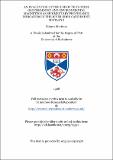An evaluation of the use of Fe-Ti oxide geochemistry and environmental magentism as sedimentary provenance indicators in the River Eden catchment Scotland
Abstract
The potential of geochemical and magnetic measurements in sedimentary provenance studies is evaluated in the River Eden catchment (Scotland), where three principal rock types (basalts, andesites and sedimentary rocks) are petrogenetically, temporally and spatially distinct. The northern part of the catchment, occupied by Lower Devonian andesitic rocks, is separated from the southern part of the catchment, occupied by Upper Carboniferous basaltic rocks, by a valley underlain by more erodable Upper Devonian sandstones. All rock types are partially covered by Quaternary glacial till. These four well distinguished potential sediment sources were expected to robustly fingerprint the source components of the stream sediment transported by the fluvial system defining the River Eden catchment. Mineral composition analysis together with magnetic measurements have enabled the characterisation, differentiation and, therefore, the classification of different groups within all potential sources (rocks and till) in terms of concentration, composition and grain size of Fe-Ti oxides. Stream sediment samples were also characterised using the same approaches. Raw data are analysed and interpreted graphically by scattergrams, and statistically by correlation coefficients, analysis of variance and simultaneous R- and Q-mode factor analysis. A comparison of both source and sediment characteristics is assisted principally by discriminant function analysis which leads to a qualitative estimation of each source contribution to the sediment. Linear programming is then applied in order to model quantitatively the provenance of stream sediment samples. Magnetite is found to be the best provenance indicator in the study area. Basalts have higher concentrations, Ti-content and grain size of magnetite than andesites. Till shows a wide variability in magnetite composition, its concentration being close to that of the andesites, whereas the sedimentary rocks are characterised by the scarcity or absence of magnetite. Oxidation of magnetite, eventually to hematite, is found to occur during rock crystallisation, and alteration under aerial conditions. However, during fluvial transport magnetite transforms to sphene. Despite the chemical alteration of magnetite, an environmentally-consistent qualitative provenance model is derived in this study. The sediment transported by each Eden tributary is found to be mineralogically unique as a result not only of mineralogical differences but also of the mixing proportions of the constituting sources. Although, tributary inputs are recognised downstream the River Eden course, sediment characteristics in the main course tend to be homogenised during transport. Even when magnetic parameters are more discriminating than magnetite composition, the intra-source magnetic variability and principally the magnetic interdependence of the sediment sources significantly hinder successful modelling of mixtures using linear programming methodology. More complex statistical methods and/or more discriminating and independent variables are required to achieve a complete quantitative model of the stream sediment provenance over the whole River Eden catchment.
Type
Thesis, PhD Doctor of Philosophy
Collections
Items in the St Andrews Research Repository are protected by copyright, with all rights reserved, unless otherwise indicated.

